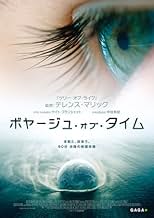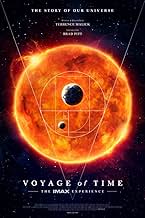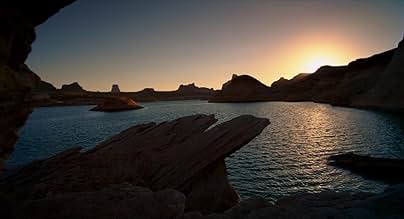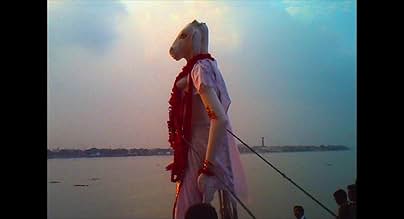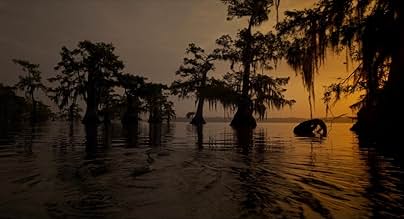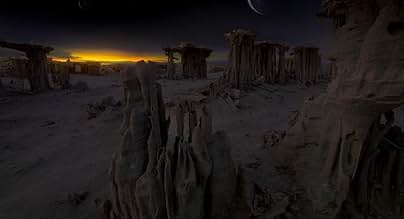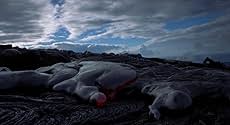Voyage of Time: Au fil de la vie
Titre original : Voyage of Time: Life's Journey
- 2016
- Tous publics
- 1h 30min
NOTE IMDb
6,5/10
5,6 k
MA NOTE
Une exploration de notre passé planétaire et une recherche de la place de l'humanité dans le futur. Avec la narration de Cate Blanchett.Une exploration de notre passé planétaire et une recherche de la place de l'humanité dans le futur. Avec la narration de Cate Blanchett.Une exploration de notre passé planétaire et une recherche de la place de l'humanité dans le futur. Avec la narration de Cate Blanchett.
- Récompenses
- 2 victoires et 5 nominations au total
Cate Blanchett
- Narrator
- (voix)
Theo Bongani Ndyalvane
- Early Human
- (as Theophilus Bongani Ndyalvane)
Histoire
Le saviez-vous
- AnecdotesTerrence Malick has been designing and working on the film with large-format cameras for over thirty years.
- Versions alternativesA 46-minute version of the film, Voyage of Time: The IMAX Experience (2016), with narration by Brad Pitt, was produced in a 3.6:1 aspect ratio for IMAX projection.
- ConnexionsReferenced in WatchMojo: Top 10 Great Movies You Missed This Fall (2016)
- Bandes originalesSymphony No. 9 in D Minor ('Choral')
Composed Ludwig van Beethoven
Performed by Nicolaus Esterházy Sinfonia and Chorus
Conducted by Bela Drahos
Courtesy of Naxos
By arrangement with Source/Q
Commentaire à la une
Viewed by Larry Gleeson during the 73rd Venice International Film Festival at the Sala Darsena Theater.
Acclaimed director Terrence Malick (Tree of Life, The Thin Red Line, Badlands) is bringing to light consciousness of the universe and what it means to be a human being in the present moment in his latest production, Voyage of Time: Life's Journey, produced by Dede Gardner, Nicolas Gonda, Sarah Green, Bill Pohlad, Sophokles Tasioulis, Brad Pitt and Grant Hill. Paul Atkins served as the Cinematographer while Dan Glass handled special effects. Keith Fraase and Rahman Ali provided editing. Cate Blanchett narrated this version.
Director Malick reached out to a Harvard Professor of Natural History and the author of Life On a Young Planet: The First Three Billion Years and Biology: How LIfe Works, Andrew Knoll, and said he wanted to make a picture about natural history and the cosmos grounded in science. Malick had long been an admirer of natural history films drawing inspiration from earlier films such as Cheese Mites, a 1903 landmark film by British cinema pioneer Charles Urban and zoologist Francis Martin Duncan, depicting the microbial world inside a piece of Stilton cheese, and George Melies' 1902 Le Voyage Dans La Lune. Knoll had seen Malick's recent film at the time, Badlands. Having enjoyed the film, Knoll agreed to be a part of it. Little did he know of Malick's appetite to thoroughly investigate and devour subjects and correlating theories.
An ambitious project in the making for over two decades, Voyage runs the gamut of time from the first cells splitting and foraging their way in and through their vacuous environment to the land of the dinosaurs and Tyrannus Rex to the dawn of man up to today and into the future with sweeping visuals and spectacular effects sure to encapsulate and stimulate the mind's imagination of time and place.
The result is a journey uncovering what shape and form time has given and what shape and form that time has taken. From the early Primordial III stars that ushered the first sparkles of light to the universe and the Tiktaalik fish that came out of the oceans to walk on land.
Special Effects Supervisor Dan Glass provided wide-ranging special effects from an Austin, Texas photographic laboratory called Skunkworks, a techie and industry term connoting radical innovation in research and development in conjunction with a variety of scientists and artists who collaborated to give representation to abstract images. While chemical experiments were conducted, a myriad of liquids, solids, and gasses were filmed at high speeds to generate a spectrum of effects as the team produced an array of stunning images.
In addition, sublime photographs from the Hubble Space Telescope, NASA's interplanetary space probes, the Solar Dynamic Observatory - a satellite observing the sun, as well as adapted supercomputer simulations and electron-microscopy are added to the production's visual cornucopia of images.
Long time cinematographer Paul Atkins was charged with assembling a series of forest and desertscapes as well as seascapes to provide backdrop for the computer generated imagery of long-lost species. To provide contrast and to remind viewers of the ebb and flow of existence - and its future- , contemporary images of humankind were collected from lo-fi Harinezumi cameras Malick handed out to people across the globe that produced warm and fuzzy, colorful images.
Sound designer Joel Dougherty created and meshed in natural and speculative sounds of the universe. Meanwhile, Music Supervisor Lauren Mikus working closely with Malick selected instrumental pieces to evoke the swirling, swelling and creative energy at both ends of the magnitude scale.
To watch Voyage of Time is a journey unto itself. Malick tells his story in a non-linear fashion allowing the viewer to create meaning from what's being shown and from what's being seen. The film opens with an establishing shot of clouds and blue skies. The shot is juxtaposed with a cut to a dystopian futurist refugee camp with fires burning. Then, a jump is made to what appears to be plasma. Cate Blanchett's voice-over begins with a soothing quality as she vocalizes, "Light giver. Light bringer. Who are you?" Blanchett continues with some pretty heady questioning throughout the rest of the film's narrative:
"What brought me here? Where are you leading me? Who am I to you? Will we always be together? Where are you? Mother, does your goodness never fail? Will you abandon me? Did love make me?" If you like stunning visuals and mind-boggling questions, I would hallucinate that this is a film for you. Recommended.
Voyage of Time will be released in two differing formats. One a 90-minute poetic foray full of open questions narrated by Cate Blanchett and the second a 45-minute giant screen adventure for all ages narrated by Brad Pitt.
Acclaimed director Terrence Malick (Tree of Life, The Thin Red Line, Badlands) is bringing to light consciousness of the universe and what it means to be a human being in the present moment in his latest production, Voyage of Time: Life's Journey, produced by Dede Gardner, Nicolas Gonda, Sarah Green, Bill Pohlad, Sophokles Tasioulis, Brad Pitt and Grant Hill. Paul Atkins served as the Cinematographer while Dan Glass handled special effects. Keith Fraase and Rahman Ali provided editing. Cate Blanchett narrated this version.
Director Malick reached out to a Harvard Professor of Natural History and the author of Life On a Young Planet: The First Three Billion Years and Biology: How LIfe Works, Andrew Knoll, and said he wanted to make a picture about natural history and the cosmos grounded in science. Malick had long been an admirer of natural history films drawing inspiration from earlier films such as Cheese Mites, a 1903 landmark film by British cinema pioneer Charles Urban and zoologist Francis Martin Duncan, depicting the microbial world inside a piece of Stilton cheese, and George Melies' 1902 Le Voyage Dans La Lune. Knoll had seen Malick's recent film at the time, Badlands. Having enjoyed the film, Knoll agreed to be a part of it. Little did he know of Malick's appetite to thoroughly investigate and devour subjects and correlating theories.
An ambitious project in the making for over two decades, Voyage runs the gamut of time from the first cells splitting and foraging their way in and through their vacuous environment to the land of the dinosaurs and Tyrannus Rex to the dawn of man up to today and into the future with sweeping visuals and spectacular effects sure to encapsulate and stimulate the mind's imagination of time and place.
The result is a journey uncovering what shape and form time has given and what shape and form that time has taken. From the early Primordial III stars that ushered the first sparkles of light to the universe and the Tiktaalik fish that came out of the oceans to walk on land.
Special Effects Supervisor Dan Glass provided wide-ranging special effects from an Austin, Texas photographic laboratory called Skunkworks, a techie and industry term connoting radical innovation in research and development in conjunction with a variety of scientists and artists who collaborated to give representation to abstract images. While chemical experiments were conducted, a myriad of liquids, solids, and gasses were filmed at high speeds to generate a spectrum of effects as the team produced an array of stunning images.
In addition, sublime photographs from the Hubble Space Telescope, NASA's interplanetary space probes, the Solar Dynamic Observatory - a satellite observing the sun, as well as adapted supercomputer simulations and electron-microscopy are added to the production's visual cornucopia of images.
Long time cinematographer Paul Atkins was charged with assembling a series of forest and desertscapes as well as seascapes to provide backdrop for the computer generated imagery of long-lost species. To provide contrast and to remind viewers of the ebb and flow of existence - and its future- , contemporary images of humankind were collected from lo-fi Harinezumi cameras Malick handed out to people across the globe that produced warm and fuzzy, colorful images.
Sound designer Joel Dougherty created and meshed in natural and speculative sounds of the universe. Meanwhile, Music Supervisor Lauren Mikus working closely with Malick selected instrumental pieces to evoke the swirling, swelling and creative energy at both ends of the magnitude scale.
To watch Voyage of Time is a journey unto itself. Malick tells his story in a non-linear fashion allowing the viewer to create meaning from what's being shown and from what's being seen. The film opens with an establishing shot of clouds and blue skies. The shot is juxtaposed with a cut to a dystopian futurist refugee camp with fires burning. Then, a jump is made to what appears to be plasma. Cate Blanchett's voice-over begins with a soothing quality as she vocalizes, "Light giver. Light bringer. Who are you?" Blanchett continues with some pretty heady questioning throughout the rest of the film's narrative:
"What brought me here? Where are you leading me? Who am I to you? Will we always be together? Where are you? Mother, does your goodness never fail? Will you abandon me? Did love make me?" If you like stunning visuals and mind-boggling questions, I would hallucinate that this is a film for you. Recommended.
Voyage of Time will be released in two differing formats. One a 90-minute poetic foray full of open questions narrated by Cate Blanchett and the second a 45-minute giant screen adventure for all ages narrated by Brad Pitt.
- HollywoodGlee
- 5 oct. 2016
- Permalien
Meilleurs choix
Connectez-vous pour évaluer et suivre la liste de favoris afin de recevoir des recommandations personnalisées
- How long is Voyage of Time: Life's Journey?Alimenté par Alexa
Détails
- Date de sortie
- Pays d’origine
- Sites officiels
- Langue
- Aussi connu sous le nom de
- Voyage of Time: Life's Journey
- Lieux de tournage
- Sociétés de production
- Voir plus de crédits d'entreprise sur IMDbPro
- Durée1 heure 30 minutes
- Couleur
- Mixage
- Rapport de forme
- 1.85 : 1
Contribuer à cette page
Suggérer une modification ou ajouter du contenu manquant

Lacune principale
By what name was Voyage of Time: Au fil de la vie (2016) officially released in Canada in English?
Répondre



